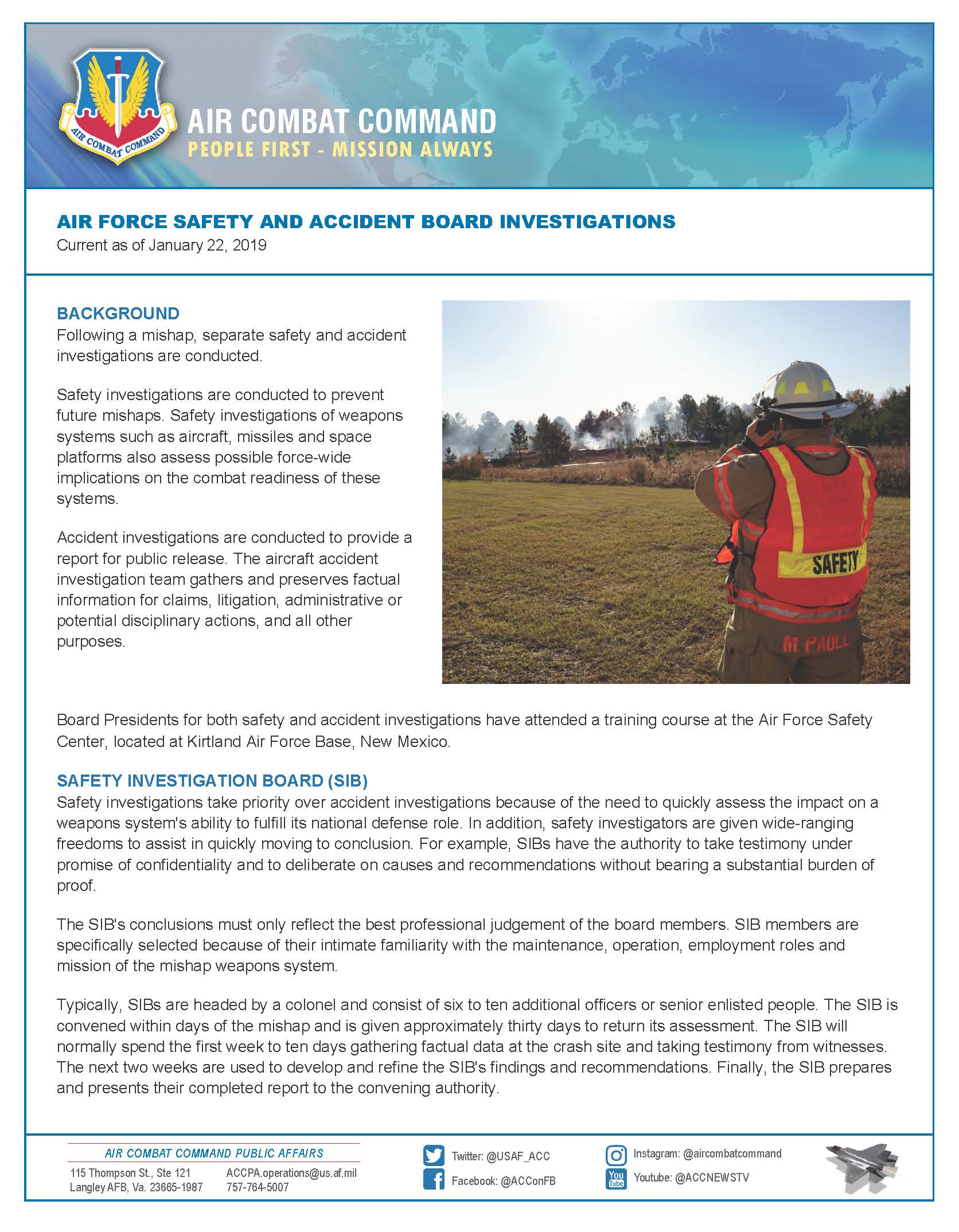Current as of January 25, 2019
Background
Following a mishap, separate safety and accident investigations are conducted.
Safety investigations are conducted to prevent future mishaps. Safety investigations of weapons systems such as aircraft, missiles and space platforms also assess possible force-wide implications on the combat readiness of these systems.
Accident investigations are conducted to provide a report for public release. The aircraft accident investigation team gathers and preserves factual information for claims, litigation, administrative or potential disciplinary actions, and all other purposes.
Board Presidents for both safety and accident investigations have attended a training course at the Air Force Safety Center, located at Kirtland Air Force Base, New Mexico.
Safety Investigation Board (SIB)
Safety investigations take priority over accident investigations because of the need to quickly assess the impact on a weapons system's ability to fulfill its national defense role. In addition, safety investigators are given wide-ranging freedoms to assist in quickly moving to conclusion. For example, SIBs have the authority to take testimony under promise of confidentiality and to deliberate on causes and recommendations without bearing a substantial burden of proof. The SIB's conclusions must only reflect the best professional judgement of the board members. SIB members are specifically selected because of their intimate familiarity with the maintenance, operation, employment roles and mission of the mishap weapons system.
Typically, SIBs are headed by a colonel and consist of six to ten additional officers or senior enlisted people. The SIB is convened within days of the mishap and is given approximately thirty days to return its assessment. The SIB will normally spend the first week to ten days gathering factual data at the crash site and taking testimony from witnesses. The next two weeks are used to develop and refine the SIB's findings and recommendations. Finally, the SIB prepares and presents their completed report to the convening authority.
The SIB Report is prepared in two parts. The first is purely factual, and the second is privileged, meaning it is to be used solely for mishap prevention and is restricted from release outside the Air Force. The factual part is passed to the accident investigation board and is incorporated in that report in its entirety. The privileged part contains testimony taken under promise of confidentiality and a record of the SIB's deliberations. Additionally, certain medical material is included in this latter part to protect individuals' privacy.
Accident Investigation Board (AIB)
The AIB will begin its investigation by reviewing the factual information from Part I of the SIB Report and additional evidence. The AIB is usually appointed immediately and will begin its investigation upon receiving Part I and additional evidence from the SIB. The board president may be a senior pilot (usually a colonel), and the other board members are a pilot, maintenance expert, flight surgeon, judge advocate and any other needed specialists.
After reviewing the SIB Part I and additional evidence, the AIB may interview witnesses and perform any additional testing required. The board president is the sole author of the AIB report, which includes the board president's opinion about what caused the mishap, using a "clear and convincing evidence" standard. The report may also describe factors that substantially contributed to the mishap using a "preponderance of the evidence" standard.
If there were fatalities or injuries, the families of the deceased or injured will be briefed privately after the report is approved and prior to public release. If a press conference is held, the AIB president serves as the Air Force spokesperson and is available to answer questions.
Report Release Timeline
AIB Reports are completed and released in approximately 60-90 days. This figure includes time after the reports are written for completion of technical review and coordination, then approval by the convening authority (the Major Command Commander), and a briefing to family members (if applicable).